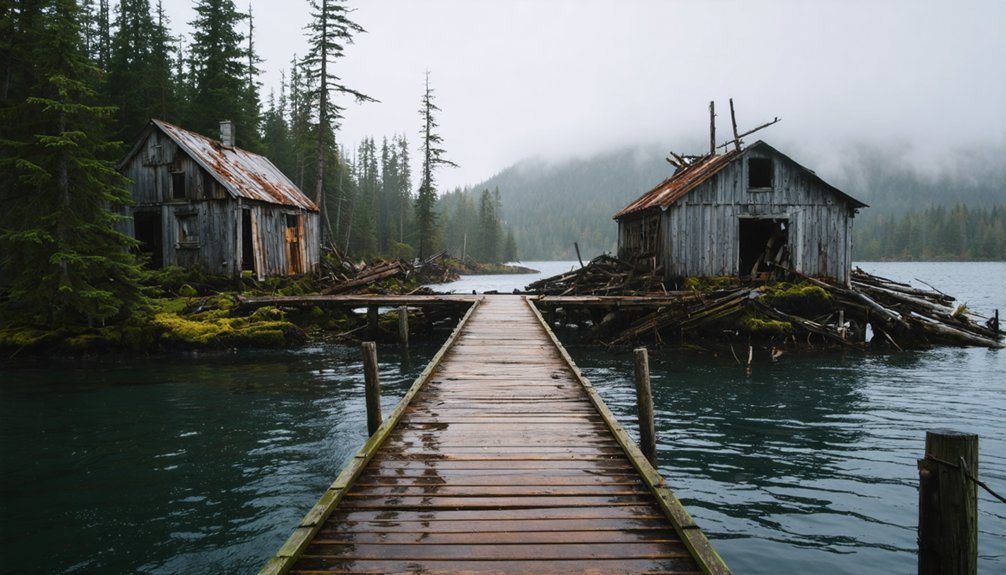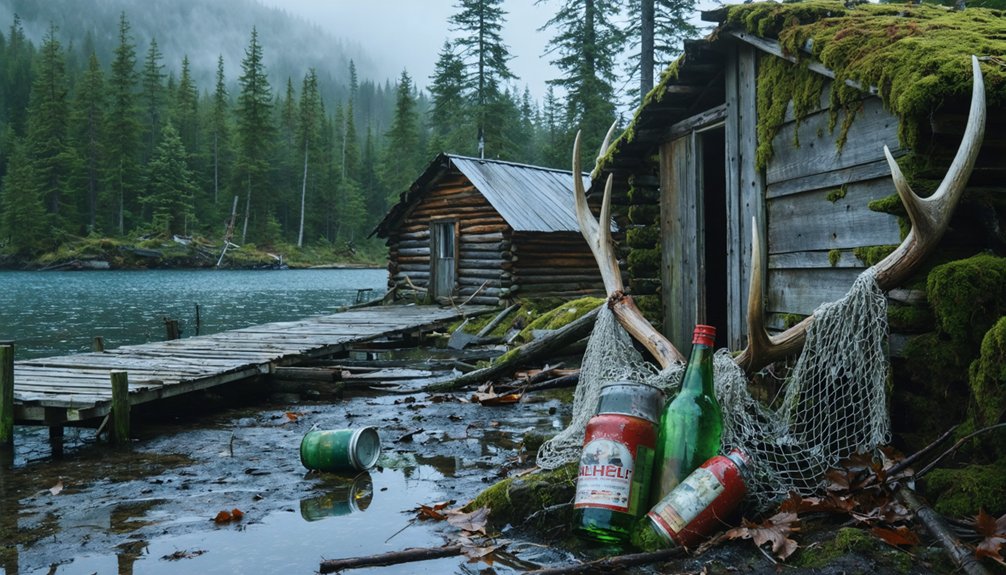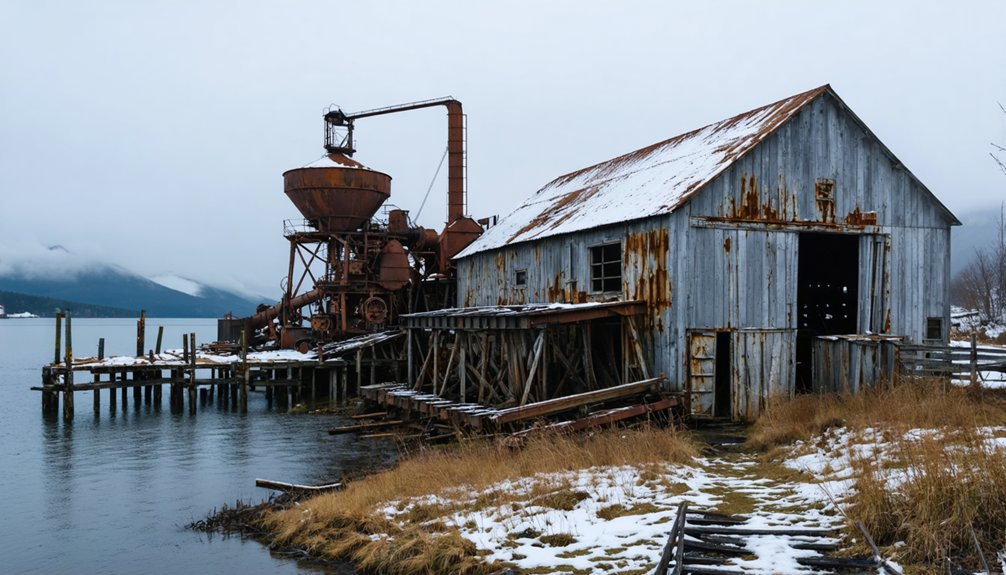You’ll find Snettisham ghost town 31 miles southeast of Juneau, where gold mining operations flourished from 1895 to 1905. The Alaska-Snettisham Gold Mining Company established the Crystal and Friday mines, employing up to 22 men who processed 35 tons of ore daily through 5-stamp and 20-stamp mills. While mining ceased in 1905 due to processing challenges, the community persisted until 1926. The site’s rich history intertwines Tlingit heritage, industrial mining innovation, and untamed Alaskan wilderness.
Key Takeaways
- Snettisham was established in 1895 following gold discoveries, operating primarily through the Alaska-Snettisham Gold Mining Company until its closure in 1905.
- The settlement featured a wharf, post office, processing mills, and salmon cannery, supporting a mixed community of miners and Tlingit people.
- Mining operations included two stamp mills and extensive tunnel networks, processing 35 tons of ore daily with a workforce of 20 men.
- The town became abandoned by 1926 due to mining challenges, though structures remain as a testament to Alaska’s gold rush era.
- Located 31 miles southeast of Juneau, the ghost town is now only accessible by boat or floatplane during summer months.
The Gold Rush Origins of Snettisham
While the Tlingit people had long inhabited the area known as Sit’ku, Snettisham’s transformation into a mining settlement began in 1895 when prospectors discovered promising gold-bearing quartz veins along the south shore of Snettisham Bay.
Like the ancient discoveries of the Iron Age hoards found in Norfolk, England, these mineral deposits revealed a rich history of precious metals in the region.
The area’s Tlingit heritage, with its established villages and fish camps of the T’aaku Kwáan, soon gave way to the rush of miners seeking their fortunes.
The Alaska-Snettisham Gold Mining Company established the Crystal and Friday mines in 1899, marking the beginning of organized mining operations in the area.
Unlike many Alaskan gold camps that focused on placer mining, Snettisham’s prospectors pursued lode mining, targeting the rich quartz veins embedded in the mountainous terrain.
Life in an Early 20th Century Mining Camp
Despite the harsh Alaskan environment, Snettisham’s mining camp bustled with activity after 1900, anchored by the Alaska-Snettisham Gold Mining Company’s operations at the Friday and Crystal mines.
In Alaska’s unforgiving terrain, Snettisham’s mines thrived, as gold seekers flocked to the Friday and Crystal operations after 1900.
You’d have found a diverse community dynamics at play, with miners working alongside Native Tlingit residents from the original Sit’ku settlement. The camp’s infrastructure included a wharf, post office, and processing mills, while cultural influences blended traditional fishing practices with industrial mining operations.
After work, you could’ve visited the salmon cannery or, by 1917, the newly established pulp mill.
Life wasn’t easy – you’d have faced technical challenges extracting gold from complex ores, and the remote location meant limited amenities. Yet the community persisted until 1926, supported by various industries even after mining ceased in 1905.
Geographic Features and Natural Surroundings
The rugged Snettisham Peninsula stretches along Alaska’s southeastern coast, positioned 31 miles southeast of Juneau where Stephens Passage meets Port Snettisham.
You’ll find yourself surrounded by dramatic geological formations, including ultramafic intrusions rich in iron, titanium, and precious metals. The area’s distinctive U-shaped fjords and steep valleys showcase the profound glacial impact that’s shaped this wild landscape. The presence of deep water shipping makes this remote location surprisingly accessible. The bay system includes three main branches, extending through the North Arm, East Arm, and South Arm.
You’re in the heart of the Tongass National Forest, where Sitka spruce and western hemlock dominate the terrain.
The Speel Glacier‘s steady retreat has created a dynamic environment of proglacial lakes, braided streams, and exposed moraines. The deep waters of Port Snettisham cut through the peninsula, while numerous creeks, including Anmer and Sweetheart, cascade down to Stephens Passage, creating a network of pristine waterways.
Mining Operations and Infrastructure
The Alaska-Snettisham Gold Mining Company’s operations centered on two key processing facilities: a 5-stamp mill established in 1900, followed by an expanded 20-stamp mill in 1901 to crush gold-bearing ore.
You’ll find that miners extracted ore through tunneling and chamber stoping techniques, with the Friday Mine featuring two substantial tunnels spanning 750 and 600 feet respectively.
The workforce, while not fully documented, likely mirrored similar regional operations that typically employed around 20 men who processed roughly 35 tons of ore daily.
Gold Processing Methods
Mining operations at Snettisham incorporated several key processing methods to extract gold from its rich deposits. The centerpiece of their gold extraction techniques was a 20-stamp mill, which began processing ore from the Crystal Mine in 1901.
You’d find that the operation’s success relied heavily on water power, with nearby creeks feeding into a flume system that powered Pelton wheels, generating 300 horsepower for the mill’s operations.
The mineral processing challenges were significant, as miners had to deal with complex ore compositions containing pyrite and magnetite. To overcome these obstacles, they developed a systematic approach using underground tunneling and drifting across multiple levels.
They’d transport the ore via a tram system, though the difficult mineral composition continued to pose extraction challenges until operations ceased in 1905. The mine workings reached an elevation of 700 feet above tide where the richest deposits were found.
Equipment and Technical Setup
While Snettisham’s mining operations relied heavily on hydroelectric power, you’ll find its technical infrastructure extended far beyond power generation. The facility boasted 78 MW of capacity through three turbines, supported by an intricate network of tunnels and penstocks spanning 9,000 feet of excavated terrain. Alaska Electric Light and Power has continuously operated the hydroelectric system since its commissioning in 1973.
You’ll discover the mining technology was strategically positioned near ultramafic deposits rich in iron, titanium, vanadium, and platinum-group metals.
The operation’s backbone included a sophisticated 44-mile transmission network, combining both underwater and overland lines to connect with Juneau’s power grid. The system was flexible enough to provide excess power to neighboring mines like Greens Creek, while also servicing cruise ships at dock.
A deep-water channel at Stephens Passage facilitated shipping access, completing Snettisham’s thorough technical setup.
Labor Force Organization
Under the leadership of President John N. Tisdale, Snettisham’s labor dynamics reflected a hierarchical yet locally integrated workforce structure.
You’ll find the operation was carefully organized to maximize efficiency across multiple mining sites and processing facilities.
- Crystal Mine employed up to 22 men during peak production, extracting 35 tons of ore daily.
- Skilled crews operated both 5-stamp and 20-stamp mills, requiring specialized knowledge.
- Mining teams coordinated between Friday and Crystal mines, with ore being trammed between sites.
- Mixed workforce of local and imported skilled miners handled the complex pyrite- and magnetite-rich ore.
- Support staff maintained infrastructure, including the wharf and tramming systems.
The workforce operated steadily under centralized management until 1905, when Tisdale’s death and financial troubles led to the operation’s closure.
This organizational structure supported continuous operations across mining, milling, and logistics until the company’s charter was voided in 1907.
The Rise and Fall of Crystal and Friday Mines
In 1899, the Alaska-Snettisham Gold Mining Company launched its ambitious mining venture by establishing operations at the Friday and Crystal mines.
You’ll find that gold extraction proved challenging at Friday Mine due to its complex ore composition of pyrite and magnetite within quartz veins. While Friday Mine started with two tunnels and a 5-stamp mill, Crystal Mine joined operations in 1901 with a larger 20-stamp mill.
By 1903, both mines operated under Alaska-Snettisham’s control, with Crystal’s ore being transported to Friday’s mill for processing. Despite initial promise and extensive underground workings of over 2,300 feet at each site, both mines faced decline by 1905 due to ore depletion and technical difficulties.
Though sporadic mining continued into the 1930s, neither mine ever regained significant production levels.
Remnants of a Forgotten Boomtown
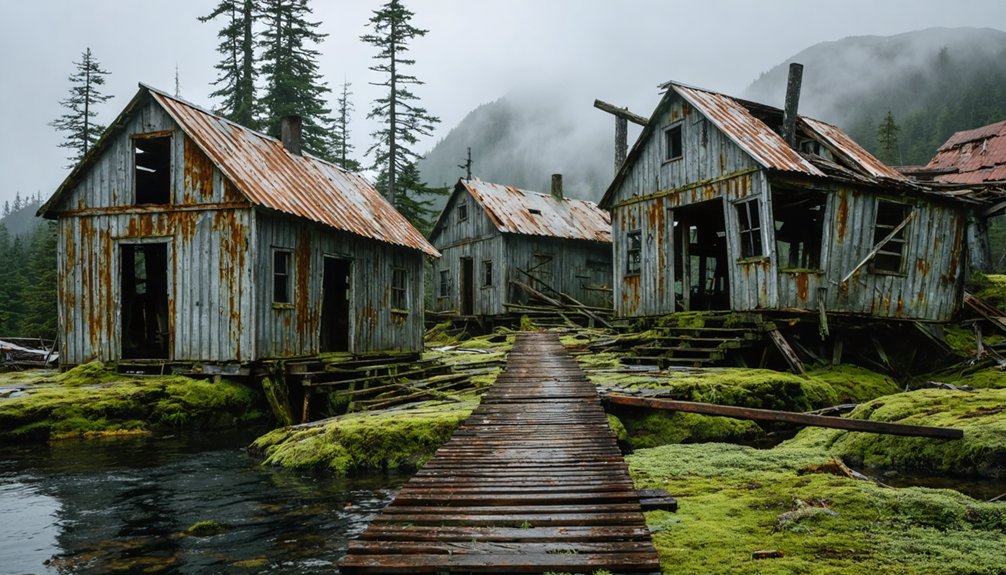
You’ll find scattered foundations and ruined structures throughout Snettisham’s former boomtown site, where some mining buildings still stand roofless against the Alaskan elements.
While copper and brass components were salvaged before abandonment, many historical remnants persist, including mill sites and mining infrastructure that tell the story of the town’s industrial past. Similar to Kennicott’s sudden abandonment, personal belongings and set dinner tables were left behind as residents quickly departed.
The surrounding forest has steadily reclaimed much of the mining camp, with rain-soaked vegetation pushing through concrete foundations and wrapping around the weathered remnants of this once-bustling community. Today, this remote location can only be reached by boat or plane, making it an isolated testament to Alaska’s mining history.
Mining Structures Still Standing
Situated 50 kilometers southeast of Juneau, the abandoned mining structures of Snettisham stand as evidence to Alaska’s rich mining heritage on United States Forest Service lands.
You’ll find these remnants nestled near the Stephens Passage deep water shipping channel, where geological exploration challenges haven’t deterred preservation efforts. Early technological advancements are evident in the electrical wiring remnants that date back over 120 years. Similar to the A-J Mine operations, workers here engaged in hand sorting methods to improve efficiency and reduce costs.
The site’s mining heritage preservation is reflected in several remaining structures:
- Clinopyroxenite formations containing Fe, Ti, V, Pt, and Pd deposits
- 48 unpatented federal mining claims, now owned by Alaska Energy Metals
- Infrastructure positioned near the Snettisham Hydroelectric Facility
- Original tunnels and mills from early mining operations
- Deep water access points used for mineral transportation
These structures represent a complex geological history within Alaska-type ultramafic intrusions, offering a glimpse into the region’s industrial past while presenting opportunities for future development.
Historic Equipment Left Behind
Though mining operations ceased decades ago, abandoned equipment scattered throughout Snettisham tells a compelling story of Alaska’s industrial heritage.
You’ll find typical remnants of a once-bustling mining operation, including ore carts, rail tracks, and fragments of steam boilers left behind when removal costs exceeded their scrap value.
Like many remote Alaskan mining sites, Snettisham’s abandoned machinery has faced three common fates: complete removal, salvage for valuable materials, or natural deterioration.
While no detailed inventory exists of the historical artifacts remaining at Snettisham, you can still discover traces of mining equipment similar to other ghost towns in the region.
Time and the harsh Alaskan elements have taken their toll, transforming what was once cutting-edge industrial equipment into weathered reminders of the area’s resource extraction past.
Nature Reclaims Mining Camp
Since the last miners departed in 1905, Southeast Alaska’s temperate rainforest has steadily reclaimed the Snettisham mining camp, transforming industrial scars into a seamless part of the surrounding wilderness.
You’ll find nature’s reclamation happening at an accelerated pace in this high-rainfall environment, where the forest enthusiastically erases human presence:
- Mosses and ferns quickly colonize abandoned buildings and equipment
- Berry bushes attract wildlife back to former industrial areas
- Tree roots crack through concrete foundations and mine entrances
- Wooden structures rot and collapse in the persistent moisture
- Salmon streams recover as vegetation filters mining runoff
The return to ecological balance is nearly complete – where mine tailings once scarred the landscape, you’ll now see thick undergrowth and towering trees, with bears and deer roaming freely through what was once a bustling boomtown.
Wildlife and Natural Resources Today
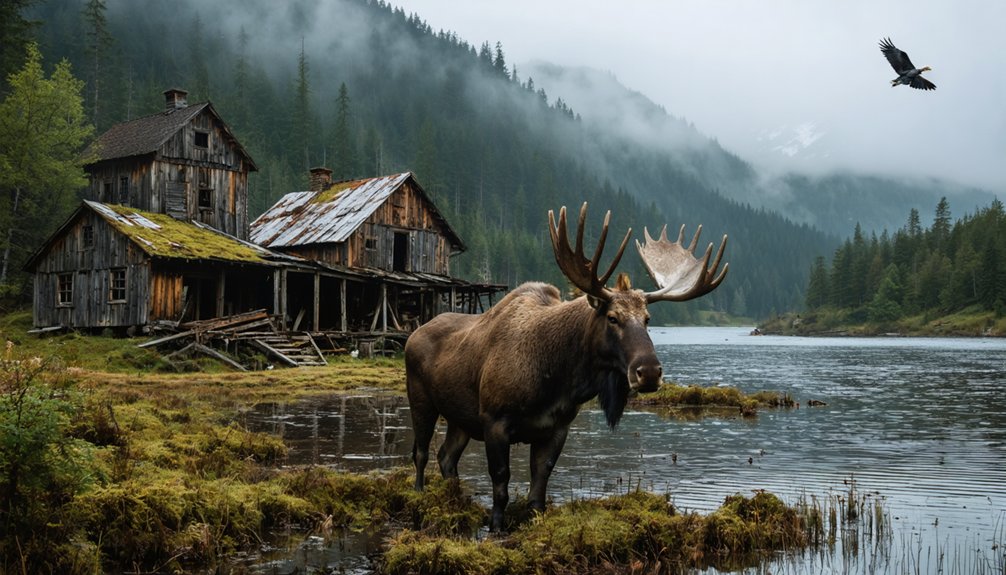
While Snettisham exists today as a ghost town, its surrounding ecosystem remains vibrant with diverse wildlife populations and valuable natural resources.
You’ll find carefully managed salmon runs, with the Snettisham Hatchery releasing 6 million sockeye smolts annually as part of regional wildlife conservation efforts. The area’s protected waters support two distinct harbor porpoise populations, though they face challenges from fishing activities in nearby channels.
The region’s freshwater systems teem with various fish species, attracting eagles, ospreys, and bears that depend on seasonal salmon runs. Small mammals and insects thrive in the surrounding terrain, creating a complex food web that connects aquatic and terrestrial environments.
Strict salmon management practices, including mesh size restrictions and protected zones, help maintain this delicate ecological balance.
Accessing the Remote Ghost Town
You’ll need to plan your visit to Snettisham carefully, as this remote ghost town is accessible only by helicopter charter from nearby locations like Skagway during summer months or by boat via Stephens Passage.
During winter months, access becomes more challenging due to harsh weather conditions, making summer the ideal time for exploration.
While chartering transportation can be expensive, your options include scheduling flights with local aviation services or arranging water transit through boat operators familiar with the coastal route.
Transportation Methods Available
Due to its remote location in Southeast Alaska, accessing the ghost town of Snettisham requires careful planning and specialized transportation methods. Floatplane charters from Juneau offer the most reliable access, with flights accommodating 2-9 passengers per trip.
Private boating presents an alternative, though you’ll need extensive experience to navigate the challenging waters and weather conditions.
Here’s what you need to know about reaching Snettisham:
- Floatplane charters cost around $900 round-trip for four people from Juneau
- No roads, ferries, or scheduled commercial flights serve the area
- Private boats must navigate 25+ miles of open water with strong currents
- Satellite phones are essential as there’s no cell coverage
- You’ll need to bring all supplies as no services exist in the ghost town
Routes and Seasonal Access
Beyond the initial transportation arrangements, timing your visit to Snettisham requires careful consideration of seasonal access patterns.
You’ll find the most favorable window between May and September when snow levels decrease and trail conditions improve. During this period, you’ll encounter fewer seasonal challenges that typically restrict access.
Be aware that spring ice break-up creates dangerous class four rapids at river crossings, while late summer storms can quickly deteriorate trail conditions.
You’ll need to navigate through rugged terrain and dense forests, where unmarked trails often demand scrambling skills. The lack of maintained roads means you’re dependent on seasonal conditions, with any existing access routes usually limited to summer months.
Plan for sudden weather changes in this remote setting, as storms can close routes without warning and strand unprepared visitors.
Historical Significance in Alaskan Mining
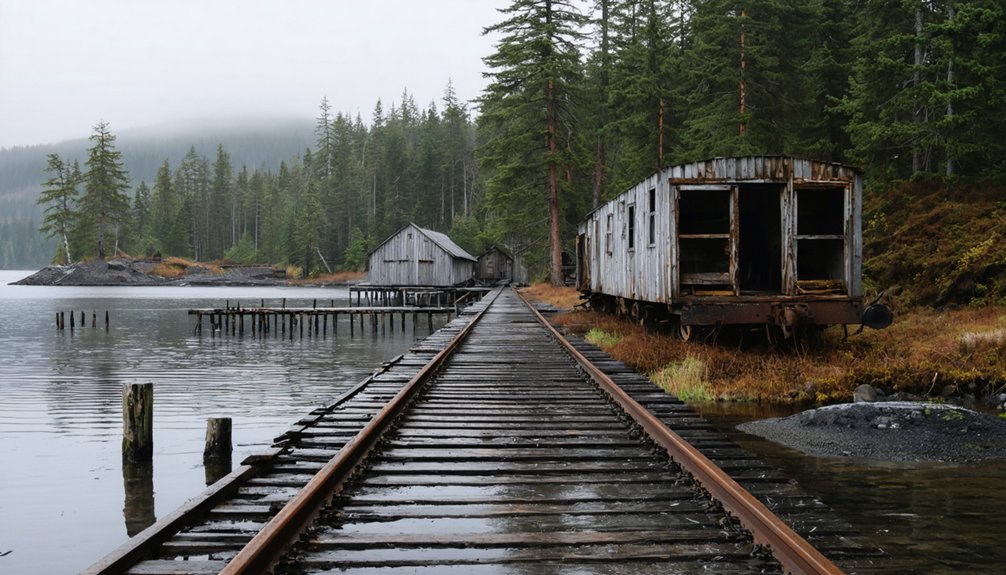
Established in 1895, Snettisham emerged as a significant gold and silver mining settlement near Juneau, Alaska, within the traditional territory of the Tlingit T’aaku Kwáan people. The Alaska-Snettisham Gold Mining Company led operations from 1899, reflecting both the region’s rich Tlingit heritage and its shift into an industrial mining hub.
Alaska’s Snettisham mining town bridged two worlds, transforming ancestral Tlingit lands into a bustling gold and silver frontier.
- Friday mine featured extensive 750-foot and 600-foot tunnels
- Crystal mine boasted 2,300 feet of underground workings
- Company’s capital stock reached $892,820 by 1902
- Mining operations struggled with complex ore composition
- Economic decline led to closure by 1905
Despite technological advancements including a 20-stamp mill, the mines couldn’t overcome challenges posed by pyrite and magnetite-rich ore.
The company’s charter was voided in 1907, though small-scale mining persisted until the 1930s, marking Snettisham’s gradual shift to ghost town status.
Modern Day Exploration Opportunities
While Snettisham’s mining operations ceased nearly a century ago, the ghost town now offers unique exploration opportunities for modern-day adventurers and researchers.
You’ll need to access the site by boat or floatplane, as there’s no road infrastructure connecting to Juneau, 50 kilometers away. The area’s geological surveys indicate rich deposits of iron, titanium, vanadium, and platinum, attracting renewed interest in mineral rights.
If you’re planning to explore, you’ll find the structures largely reclaimed by forest, requiring guided tours for safety.
The proximity to the Snettisham Hydroelectric Facility provides potential power support for research operations. While unguided exploration of outdoor ruins is possible, you’ll need permits for any formal geological work or building access through the U.S. Forest Service.
Frequently Asked Questions
What Caused the Final Closure of the Pulp Mill in Snettisham?
You’ll find the pulp mill closed due to severe economic decline, requiring $200 million in environmental upgrades while facing timber shortages, reduced federal contracts, and mounting pressure from environmental regulations.
Are There Any Remaining Year-Round Residents in Snettisham Today?
You won’t find any year-round habitation at this location today. The only people you’ll encounter are rotating maintenance crews for the hydroelectric facility and seasonal hatchery workers during their shifts.
What Indigenous Tribes Originally Inhabited the Snettisham Area?
You’ll find the Tlingit culture was predominant in Snettisham’s early history, with their indigenous traditions deeply rooted in the coastal area, while Alutiiq and Dena’ina peoples occasionally interacted there.
Have Any Artifacts From the Mining Era Been Preserved in Museums?
While mining artifacts from Snettisham aren’t specifically documented in major museum exhibits, you’ll find general Alaska mining collections at Juneau’s Last Chance Mining Museum and other regional historical institutions.
Was Snettisham Ever Officially Incorporated as a Town or City?
You won’t find records of Snettisham being officially incorporated, despite its historical significance as a mining settlement. It operated more like a work camp than a formal town with municipal status.
References
- https://www.youtube.com/watch?v=Cz0IGc2Uy0E
- https://dggs.alaska.gov/webpubs/usbm/ri/text/ri5195.pdf
- https://www.youtube.com/watch?v=GNjMpM6b58o
- https://www.onlyinyourstate.com/experiences/alaska/abandoned-places-in-ak
- https://en.wikipedia.org/wiki/List_of_ghost_towns_in_Alaska
- https://www.batchgeo.com/map/ghost-towns
- https://en.wikipedia.org/wiki/Snettisham
- https://coastview.org/2023/05/11/port-snettisham-speel-river/
- https://www.nps.gov/articles/alaska-goldrush-national-historic-landmarks.htm
- https://dggs.alaska.gov/webpubs/usbm/ofr/text/ofr085_86.pdf
